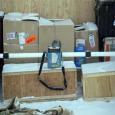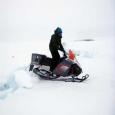April 12: "IPY Live", the EM-31, and Snow.
Wind speed 10.5 mph
Air Temperature -14.8 C 5.4 F Wind chill -11.1 F
Latitude 73—11.238 N
Longitude 146—36.331 W
After breakfast Cathy and I prepared for our"Live from IPY" event. A conference call and slide show to schools from the ice camp. During the call we talked with a number of people.
Peggy Foletta, CA, Grade 10 Honors Biology, 25 students
Bandon Gillette, KS, Grade 8 Earth Science, 25 students
Jo Dodds, ID, Grade 9 Earth Science, 27 students
Linda Cassassa, AK, Grade 7-12, 23 students
Geoff Haines Stiles, NJ
Hans Mueller, NH
Lollie Garay, TX, Grade 5 science, 28 students
Tania Giberyen, Luxembourg
Kirk Beckendorf, TX, Grade and # students unknown
Toward the end of the talk a plane from the Danish Space Agency, carrying a special laser instrument to measure the snow surface, arrived.

The pilots reported two polar bears a couple of miles outside of camp; a female and an older cub. I talked with the pilots and they told me that the bears had caught a seal for dinner. The bears must have been pretty happy where they were because we never saw them around camp. Which was just as well, and ok by me.

After Lunch Andrew Roberts and I headed out with the EM-31 to measure ice thickness at a number of stations that had not been done. We were under a time deadline, because the EM-31 had to be shipped the next day to scientists in Barrow for their use. After the polar bear warning everyone was even more careful, keeping their eye out for bears. Andrew was very efficient and on the snowmobile we were able to cover a lot of ground. We made a strong effort to reach as many stations as possible crossing several leads, and working well into dinner.

Andrew and I had a good talk about ice and snow as we worked. I had learned from Jackie Richter-Menge that satellites do a good job of measuring the ice surface extent (amount of ice cover). The area covered by the ice in the Arctic Ocean has been decreasing. But satellites are not so good for measuring the thickness of the ice. To measure ice thickness multibeam sonar, EM-bird, EM-31 and augur holes with measuring tape are used.

Andrew and I talked about the influence that snow has on the ice. Snow can act as an insulating blanket and protect the ice from cold air temperatures, slowing or stopping ice thickness growth. Ice also reflects about 60% of the incoming sunlight, while snow reflects 80%. The amount of snow cover on the ice is very variable. In order to understand this snow influence, the snow sampling team has been taking measurements.

Some of the measurements are with the Magna probe. The Magna probe looks like a stainless steel staff with a pie plate attached. The circular disk sits on the snow, and an electric current creates a magnetic field that measures the distance between the staff point and the disk. One of the questions asked about global warming is, will the amount of snow on the sea ice increase (more open water means more moisture, which could mean more snow) or decrease (because of increased temperatures), and how will this influence the sea ice?

Comments